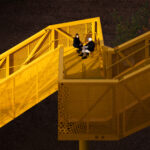Last night, the latest design for Google’s new Charleston East campus in Silicon Valley went under review at a public hearing in Mountain View. Recent renderings by Bjarke Ingels Group and Heatherwick Studio, the team behind the project, reveal a much smaller, darker and more subdued design than the first iteration unveiled in 2015.

Google’s Charleston East Campus via designboom
Due to a last-minute land swap last year with LinkedIn, Google’s campus moved to its current site, which allows them 595,000 square feet, thus rendering a more compact program. Besides the size of the building, another major element changed: the project’s gargantuan roof. The original, protective glass bubble that enveloped the campus filtered in endless daylight, showcased activity within the structure and alluded to a more transparent and — some might argue — honest company culture.

Original design proposal for Google; via Heatherwick studio

Original design proposal for Google; via Heatherwick studio
Now, the roof is everything but inviting. Featuring a tent-like canopy made of gray, curved metal squares, the building itself is overwhelmed. Natural light is diffused through crescent-shaped clerestories in between the undulating layers of the canopy, which houses large photovoltaic solar panels. The roof also regulates indoor climate, air quality and sound. These are impressive technical features, but with less aesthetic curb appeal.

Updated renderings for Google’s Charleston East Campus; via designboom
The ground level of the campus includes a series of pavilions that wrap around a public green loop, which not only serves as a walking and biking path, but hosts the array of cafés and shops that line it.

Updated renderings for Google’s Charleston East Campus; via designboom
This is Google’s first time constructing an office from scratch rather than transforming an existing structure. The company is seeking to make Charleston East a “community hub” with various outdoor programming available for locals to use day and night. As a campus that claims to promote collaboration with those outside of the company walls, the dark canopy does nothing for Google’s public face but cause confusion about its values on openness and accountability.

Updated renderings for Google’s Charleston East Campus via designboom
In defense of the design, however, this latest set of renderings was conceived specifically for the planning documents needed for review by the city council. Knowing BIG and Heatherwick, future iterations could incorporate vast improvements. Still, the dark cloud of the canopy remains.
Fifteen miles south of Charleston East is Foster + Partners’ near-complete design for the newly named Apple Park — a new headquarters for the tech giant that is truly out of this world. The 175-acre campus will begin relocating its 12,000 employees there starting next month.
Already described as a massive spaceship and touted as one of the world’s most energy-efficient buildings, the more-than-a-mile-long looping structure is a major design innovation. It holds the record for world’s largest panels of curved glass as well as for world’s largest naturally ventilated construction. Inside, a vast, circular “courtyard” incorporates two miles of walking and running paths and an orchard, meadow and pond. Nonemployees have access to a large Apple Store and café.

Apple Park via Apple
While the interior may not be as fluid and open as Google’s Charleston East, the design for Apple HQ is, architecturally speaking, stunning. Both companies clearly have different goals in creating connectivity throughout their offices and also seem to desire integration with the wider community, though Google — as with its other campuses — includes more room for that kind of activity.


Apple Park via Apple
Neither building is particularly more welcoming than the other. Both stand out quite unabashedly amid the neighborhoods they exist in. But at the end of the day, Apple Park maintains an air of authority and forward-thinking in its design. So far, Google does not.
Future versions might bring more direct sunlight into the structure through its tent-like rooftop, but much depends on last night’s public hearing. Because community input is an important part of the approval process for Google, locals will have a considerable say in the end result.
Video via Apple









